The rollout of On-Board Diagnostics, better known as OBD2, marked a turning point in automotive history. But pinpointing exactly when OBD2 started being used in cars can be surprisingly tricky. This comprehensive guide will explore the history of OBD2, its implementation timeline, and how this technology revolutionized vehicle diagnostics.
While the concept of on-board diagnostics existed before, the OBD2 standard we know today wasn’t mandated in the United States until the 1996 model year. This means that any vehicle manufactured in 1996 or later was required to be OBD2 compliant.
Why Was OBD2 Introduced?
Before OBD2, each automaker had its own diagnostic system, making it challenging for mechanics to diagnose and repair vehicles from different manufacturers. This lack of standardization led to inefficiencies and increased costs for car owners. The Environmental Protection Agency (EPA) introduced OBD2 to address these issues and:
- Improve Air Quality: A primary goal of OBD2 was to reduce harmful emissions from vehicles. By standardizing the way cars monitored and reported engine performance, the EPA aimed to ensure that vehicles ran more cleanly and efficiently.
- Standardize Diagnostic Procedures: With a universal system, mechanics could diagnose problems more easily, regardless of the vehicle’s make or model.
- Empower Car Owners: OBD2 provides car owners with valuable information about their vehicles’ health, empowering them to take proactive steps in maintenance.
The Evolution of OBD2
While 1996 marked the year OBD2 became mandatory in the U.S., the story doesn’t begin there. To fully grasp the significance of this technology, we need to look at the stages leading up to its widespread adoption:
- Early OBD Systems (Pre-1991): These rudimentary systems were specific to certain makes and models and often provided limited information.
- OBD1 (Early 1990s): OBD1 represented a step forward but still lacked standardization. Different manufacturers used different connectors and protocols.
- OBD2 (1996 – Present): The 1996 implementation of OBD2 in the U.S. revolutionized car diagnostics, leading to a universal standard for emissions monitoring and diagnostics.
OBD2 Beyond the U.S.
The adoption of OBD2 wasn’t limited to the United States. While the U.S. led the way, other regions followed suit:
- Canada: Adopted OBD2 simultaneously with the U.S. for the 1996 model year.
- Europe: Implemented a similar standard called EOBD in 2001 for gasoline vehicles and 2004 for diesel vehicles.
- Other Regions: Many countries globally have since adopted OBD2 or similar standards, making it a truly global system.
How OBD2 Works
OBD2 works by monitoring various systems within a vehicle, primarily focusing on those that impact emissions. When a potential issue is detected, the system stores a diagnostic trouble code (DTC) in the vehicle’s computer. This code can then be retrieved using an OBD2 scanner, which acts as a window into your car’s computer system.
Beyond 1996: OBD2 Today
OBD2 has come a long way since its inception. Here are some key advancements and trends:
- Enhanced Diagnostics: Modern OBD2 systems can monitor an even wider range of vehicle systems, providing more comprehensive diagnostic information than ever before.
- Wireless Connectivity: Many OBD2 scanners now offer Bluetooth or Wi-Fi connectivity, allowing users to access real-time data and diagnostics wirelessly.
- Smartphone Integration: Numerous apps are now available that leverage the power of OBD2, enabling users to monitor vehicle performance, track fuel economy, and even diagnose issues directly from their smartphones.
FAQs About When OBD2 Started Being Used in Cars
Q: Does my 1994 car have OBD2?
A: While some 1994 models might have some OBD2-like features, they are not likely fully compliant. 1996 marked the first year of mandatory OBD2 compliance in the U.S.
Q: How can I tell if my car is OBD2 compliant?
A: Most OBD2-compliant vehicles will have a sticker under the hood stating “OBD2 Certified” or similar. Additionally, the OBD2 port is typically located under the dashboard on the driver’s side.
Q: What are the benefits of using an OBD2 scanner?
A: OBD2 scanners can help you:
- Diagnose engine problems
- Reset the check engine light
- Monitor vehicle performance
- Track fuel economy
- And much more
Conclusion
Understanding when OBD2 started being used in cars is crucial for any car owner or enthusiast. This groundbreaking technology revolutionized car diagnostics and paved the way for the advanced systems we rely on today. From its initial implementation in 1996 to its continued evolution, OBD2 continues to be an indispensable tool in the automotive world.
If you’re looking to explore the world of OBD2 and learn more about how to use this powerful technology, OBDFree is your trusted resource. We offer comprehensive guides, reviews, and insights to help you navigate the world of car diagnostics with confidence. Contact our team at WhatsApp: +1(641)206-8880, Email: cardiagtechworkshop@gmail.com. We are available 24/7 for all your car diagnostic needs.


